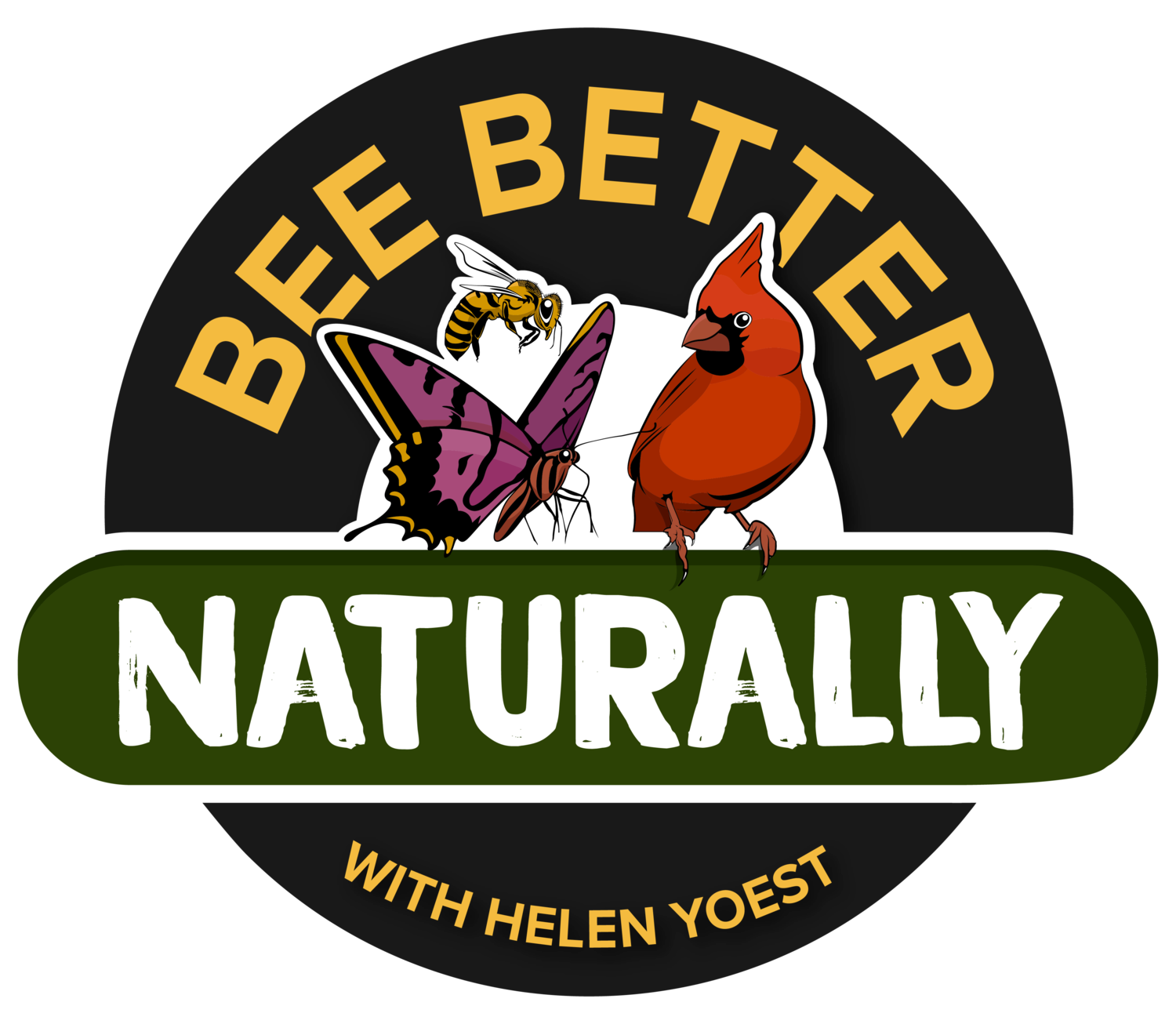Pollinators will find what they need, no matter what; yes, even shade-loving plants have a pollinator.
The first thing to consider in selecting plants for shade is knowing the type of shade you have. Here’s is a Bee Better Naturally post that will help with this.
Remember, too, there is a lot of overlap. Don’t get too worried if your area is part sun or part shade. Measure the amount so you know for sure! Also, when is it shady. Morning sun is kinder than afternoon sun.
Here’s something to note for shade gardens. Have you ever noticed carpenter bees flying up against the windows of your house or hovering around dark holes in the lawn? Generally speaking, carpenter bees prefer to nest in shady areas. Find a location away from your home for nesting bees. Build a wood pile somewhere in a shady spot; it can even be in a less visible area. A wood pile is also shelter for a wide number of species including, snakes, lizards, chipmunks, and insects for birds to feed.
PARTIAL SUN / PARTIAL SHADE: These two terms are often interchangeable to mean 3-6 hours of sunlight each day. While the terms are interchangeable, there is a default understanding.
Partial shade typically refers to morning and early afternoon sun, while a plant listed as partial sun, relief from the intense late afternoon sun is needed. This shade could be from a structure or the shade from an old oak tree.
Bulbs
Lily of the Valley, Convallaria majalis
Annuals
Jewelweed, Impatiens balsamina
Money plant, Lunaria annua
Toad Lily
Perennials
Campanula, Campanula americana
Columbine, Aquilegia canadensis
Blue mist flower, Conoclinium coelestinum
Early meadow-rue, Thalictrum dioicum
Joe-pye weed, Eutrochium purpureum
Cardinal flower, Lobelia cardinalis
Downy skullcap, Scutellaria incana
Meadowsweet, Thalictrum dioicum
Turk's Cap, Lilium superbum
Snakeroot, Ageratina altissima
Broadleaf goldenrod, Solidago flexicaulis
Toad Lily, Tricyrtis hirta
Lawn Violets, Viola spp.
Wild geranium, Geranium maculatum
Eastern Sweetshrub
Shrubs
Glossy abelia, Abelia x grandiflora
Red chokeberry, Aronia arbutifolia
Common sweetshrub, Calycanthus floridus
Summersweet, Clethra alnifolia
Cornelian cherry dogwood, Cornus mas
Red twig dogwood, Cornus sericea
Winter hazel, Corylopsis pauciflora
American Hazelnut, Corylus americana
Daphne, Daphne spp.
Paperbush, Edgeworthia chrysantha
Dwarf fothergilla, Fothergilla gardenii
Common Witch hazel, Hamamelis virginiana
Oakleaf hydrangea, Hydrangea quercifolia
St. Johnswort, Hypericum calycinum
American holly, Ilex opaca
Virginia sweetspire, Itea virginica
Mountain Laurel, Kalmia latifolia
Leucothoe, Leucothoe axillaris
Northern bayberry, Myrica pensylvanica
Mock orange, Philadelphus spp.
Rhododendron, Rhododendron spp.
Fragrant sumac, Rhus aromatica
Tree Peony, Paeonia suffruticosa
Viburnum, Mapleleaf, Viburnum acerifolium
Viburnum, Arrowwood, Viburnum dentatum
Blackhaw, Viburnum prunifolium
Flowering Dogwood
Trees
Japanese maple, Acer palmatum
Red maple, Acer rubrum
Red buckeye, Aesculus pavia
Serviceberry, Amelanchier canadensis
Pawpaw, Asimina triloba
Flowering dogwood, Cornus florida
Eastern Redbud, Cercis canadensis
White fringe tree, Chionanthus virginicus
Carolina silverbell, Halesia tetraptera
Persimmion, Diospyros virginiana
Sweetbay magnolia, Magnolia virginiana
Sourwood, Oxydendrum arboreum
Staghorn sumac, Rhus typhina
Ground Covers
Bishop’s weed, Aegopodium podagraria
Plumbago, Ceratostigma plumbaginoides
‘Tangerine Beauty’ Cross Vine
Vines
Crossvine, Bignonia capreolata 'Tangerine Beauty’
Trumpet vine, Campsis radicans
DAPPLED SUN: Dappled sunlight is my favorite kind of sun, if I had to choose. Dapple sun is similar to partial shade. The plants are getting partial sun as it makes it’s way through the branches of a deciduous tree. Woodland plants and under plantings, even for many mosses, prefer dappled sunlight more so than partial shade.
Bulbs--under deciduous trees, providing a shady spot when they are in bloom.
Crocus, Crocus vernus
Daffodil, Narcissus
FULL SHADE: Full shade means less than 3 hours of direct sunlight each day, best if it’s morning light. But even in the absence of direct sunlight, full shade can be a bright light. Plus, full shade likes a filtered sunlight the remainder of the day. Every plant needs some sun; even those that thrive in full shade.
Virginia Bluebells, Mertensia virgin
Bulbs
Virginia Bluebells, Mertensia virginica
Annuals
Coming soon!?!
Perennials
Pigsqueak, Bergenia cordifolia
Hostas, Hosta plantaginea
Lungwort 'Lewis Palmer’, Pulmonaria 'Lewis Palmer’
White Wood Asters, Eurybia divaricata
Sweet box, Sarcococca hookeriana var. humilis
Shrubs
Sweet box, Sarcococca hookeriana var. humilis
Trees
American hornbeam, Carpinus caroliniana
Mahonia, Mahonia japonica
Vines
Climbing hydrangea, Hydrangea anomala subsp. petiolaris
Coral bells, Heuchera species and hybrids
Ground Covers
Blue Cohosh, Caulophyllum thalictroides
Bugleweed, Ajuga reptans
Wild Ginger, Asarum canadense
Astilbe, Astilbe species and cultivars
Lenten rose, Helleborus orientalis
Coral bells, Heuchera species and hybrids
Foamy bells, Heucherella hybrids
Russian arborvitae, Microbiota decussata
Mondo grass, Ophiopogon japonicus
Foam flower, Tiarella cordifolia









